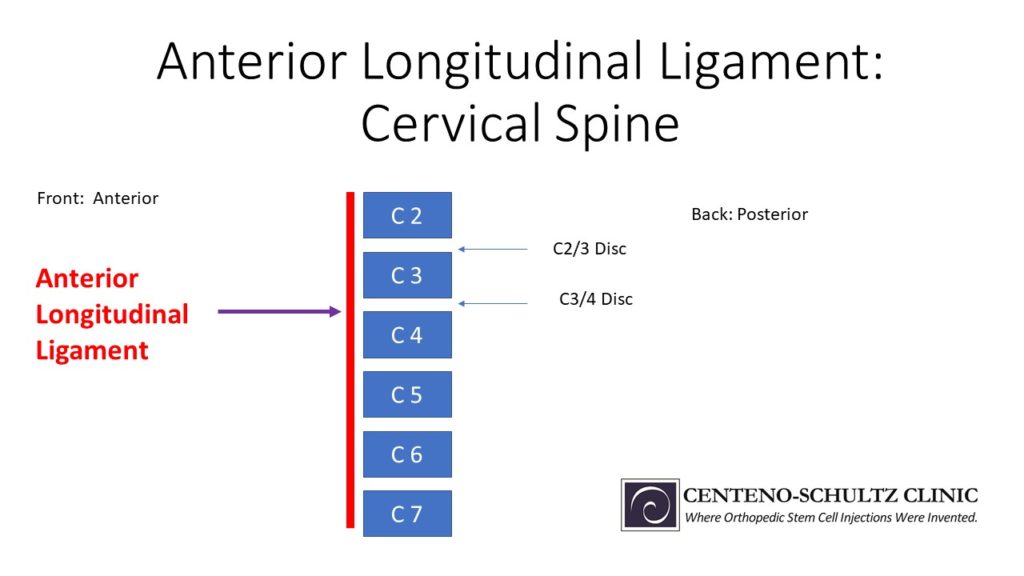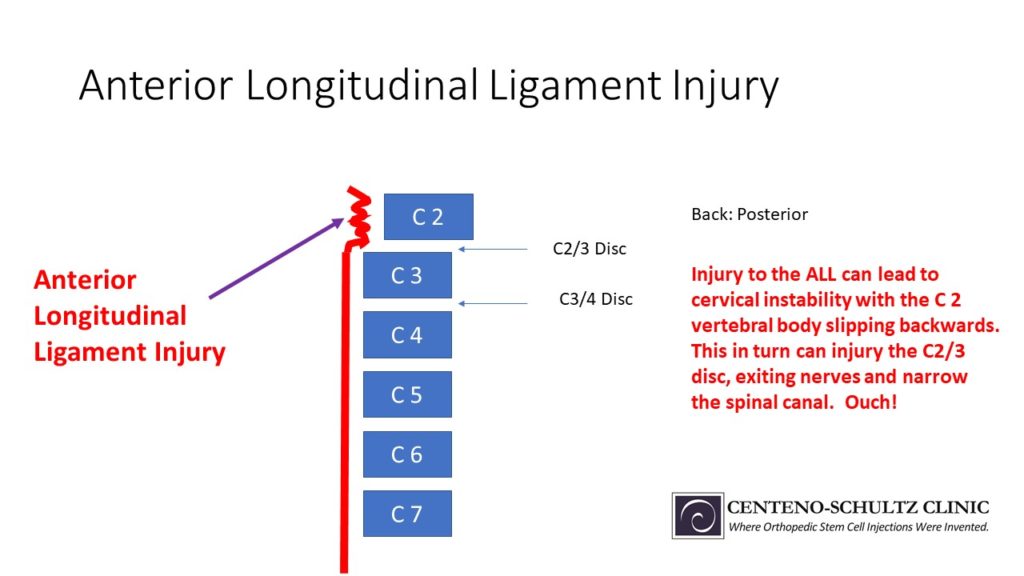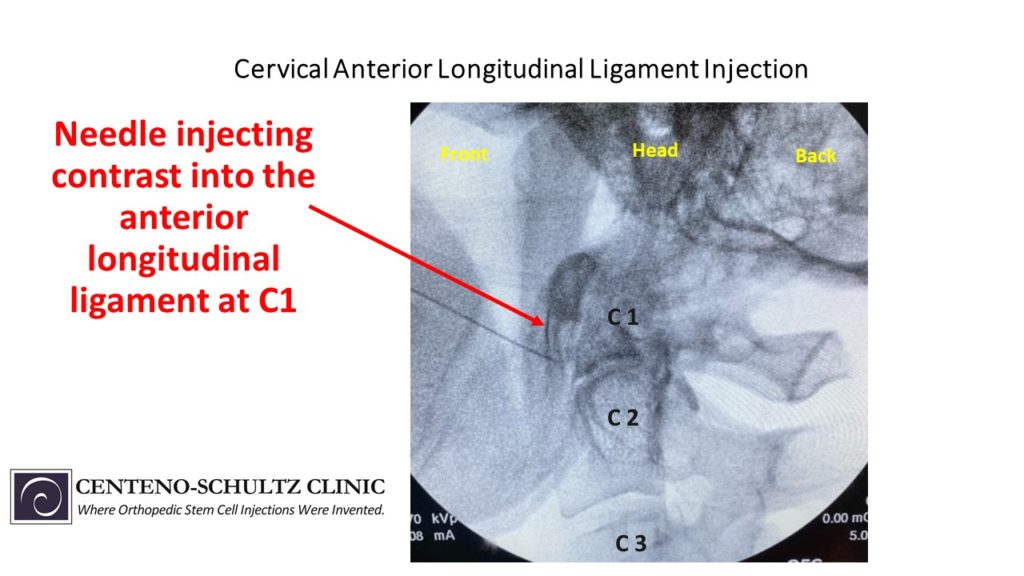The neck pain is unrelenting, and it all started after being rear-ended at a stoplight. Spine X-rays demonstrated some abnormal movement of the spinal bones. Both conservative care and medications have failed.
Your doctor thinks you have injured a spinal ligament. What is the anterior longitudinal ligament? What is its role? What ligaments are injured in a whiplash-type accident?
Are there different types of ligament injuries? What happens if the anterior longitudinal ligament is injured? Does MRI show ligament injuries? Can spinal ligaments heal and what are the limitations? What are the treatment options for injuries to the anterior longitudinal ligament? Let’s dig in.
What Is the Anterior Longitudinal Ligament (ALL)?

A ligament is a thick piece of connective tissue that connects bone to bone. Think of it as duct tape that holds bones together. The anterior longitudinal ligament (ALL) is an important ligament located in the front of the neck.
It starts at the skull’s base and extends across the cervical, thoracic, and lumbar spine, ending at the sacrum. It is approximately one inch in width and has three layers: superficial, intermediate, and deep.
The Connection Between the ALL and Neck Pain
The anterior longitudinal ligament (ALL) is a crucial structure that runs along the anterior aspect of the vertebral bodies within the spine. Its primary role is to provide stability and support by limiting excessive extension of the spine. The ALL plays a significant part in maintaining the normal curvature of the spine and preventing hyperextension of the neck.
When injuries or issues arise with the anterior longitudinal ligament, it can contribute to neck pain. Disruption or damage to the ALL can lead to instability in the cervical spine, resulting in discomfort and reduced functionality. In particular, hyperextension injuries, such as whiplash, can strain or tear the ALL, leading to inflammation and pain in the neck region.
In cases of ALL tears, individuals may experience persistent neck pain, stiffness, and a compromised range of motion. The severity of symptoms often correlates with the extent of ligament damage. Understanding the role of the ALL in spinal alignment helps shed light on the potential consequences of its injuries on neck health.
Types of ALL Tears That Can Cause Neck Pain
ALL tears can be categorized into different grades based on the severity of the strain. These grades, ranging from 1 to 3, help in understanding the extent of ligament damage and the associated symptoms. Here’s a breakdown of each grade:
- Grade 1 Sprain
This is a mild strain where the ligament is stretched but not torn. Individuals may experience minimal pain and stiffness in the neck. Range of motion is usually not significantly affected, and there might be mild discomfort during certain movements. Grade 1 strains often resolve with conservative measures such as rest, ice, and anti-inflammatory medications. Physical therapy may be recommended to promote healing and prevent further injury. - Grade 2 Sprain
A grade 2 sprain is a moderate strain characterized by partial tearing of the ligament fibers, moderate to severe neck pain, stiffness, and a noticeable reduction in range of motion. Individuals may find it challenging to move their necks without discomfort.
Treatment for grade 2 tears may involve a combination of rest, physical therapy, and in some cases, bracing to support the healing process. Anti-inflammatory medications may be prescribed to manage pain and inflammation. - Grade 3 Sprain
This is a severe strain involving a complete tear of the ligament, intense neck pain, significant loss of range of motion, and potential instability in the cervical spine. The affected individual may find it difficult to move the neck without substantial pain.
Grade 3 tears may require more aggressive interventions, including immobilization with a cervical collar or brace. Surgery might be considered in extreme cases to repair or reconstruct the torn ligament. Rehabilitation and physical therapy are crucial components of recovery.
The Susceptibility of the ALL to Whiplash
Whiplash is a neck injury due to forceful, rapid back-and-forth whipping motion of the head and neck. Whiplash can also be described as “an acceleration-deceleration mechanism of energy to the neck.”(1) The incidence of whiplash injuries varies greatly between different parts of the world.
For example, in Quebec, Canada, incidence is as high as 70 per 100,000.(2) It is estimated that there are 1,000,000 cases of whiplash per year in the United States. Injuries can be significant and long-lasting. Approximately 50% of whiplash patients have reported chronic neck pain 15 years after the trauma.(3)
Whiplash trauma can cause injury to multiple spinal structures and ligaments, facet joints, discs, muscles, tendons, and nerves. The anterior longitudinal ligament is particularly susceptible to injury due to the rapid back-and-forth whipping motion of the neck.(4) This is due to the biomechanics and rapid forces involved in such incidents.
The head is forcefully thrown back and forth, causing the neck to hyperextend and then hyperflex. This motion puts significant stress on the ALL, which functions to limit excessive extension of the spine. The abrupt change in direction during whiplash can lead to overstretching or tearing of the ligament.
The ALL runs along the anterior aspect of the vertebral bodies, making it directly exposed to the forces generated during whiplash. Its position makes it susceptible to injury as the neck extends backward and then flexes forward, causing the ligament to bear the brunt of the mechanical forces.
Ligaments, including the ALL, have limited elasticity compared to muscles.
The sudden and forceful nature of whiplash exceeds the ligament’s capacity to stretch without damage. As a result, the ALL may undergo strain or tear when subjected to the rapid and intense movements associated with whiplash trauma.
Additionally, individuals with preexisting conditions, such as degenerative changes in the spine or weakened ligaments, may be more susceptible to ALL injuries during whiplash. These preexisting vulnerabilities can compromise the ligament’s ability to withstand the mechanical forces generated in the traumatic event.
How ALL Injuries Can Impact the Body

The ALL provides critical support to the spine and discs. Injury to the ALL can cause irritation or injury to the nerves within the ligament, resulting in pain and restriction in the range of motion. ALL injury can also lead to bone formation within the ligament, causing pain and dysfunction.
ALL injuries can have a profound impact on the body, affecting both the local region of the injury and potentially leading to broader consequences throughout the spine.
Let’s delve into how ALL injuries can impact the body:
Spinal Instability
The ALL plays a crucial role in maintaining spinal alignment. Injuries to this ligament can disrupt the normal curvature of the spine, leading to misalignment. This alteration in spinal alignment may contribute to postural issues, muscle imbalances, and increased stress on adjacent structures in the spine.
Disc Injury
ALL injuries can elevate the risk of intervertebral disc injuries. The ligament helps distribute forces evenly along the spine. When compromised, there may be uneven stress on the discs, making them more susceptible to degeneration, herniation, or other disc-related issues.
Nerve Injury
In some cases, ALL injuries may be associated with neurological symptoms. Compression of nerve roots or the spinal cord due to altered spinal alignment or disc issues can result in radiculopathy, neck shoulder and arm pain, tingling, weakness, or other neurological manifestations.
Spinal Stenosis
ALL injuries can be associated with disc herniation. When a disc herniates, the displaced disc material can encroach upon the spinal canal, leading to stenosis. Chronic irritation and stress on the spinal structures resulting from ALL injuries can lead to the formation of bone spurs or osteophytes.
These bony outgrowths can encroach upon the spinal canal, narrowing its diameter and contributing to the compression of spinal nerves or the spinal cord.
Diagnosis of ALL Issues
A comprehensive assessment is crucial for diagnosing issues related to the ALL. This process involves a combination of physical examinations and advanced imaging techniques to accurately identify and evaluate the extent of ALL injuries.
Physical Examinations
Physical examinations play a pivotal role in the initial assessment of ALL issues. Skilled healthcare professionals, such as Physiatrists, orthopedic specialists or spine specialists, conduct a detailed examination of the patient’s neck and spine. Key components of the physical examination may include a range of motion assessment. Evaluating the patient’s ability to move their neck in various directions helps identify limitations and discomfort associated with ALL injuries.
Palpating the neck and spine allows clinicians to assess for tenderness, swelling, or abnormalities, providing valuable insights into potential ligamentous injuries. Assessing nerve function, reflexes, and any signs of neurological deficits helps rule out associated complications, such as nerve compression or spinal cord involvement. Specialized tests, such as stress tests or maneuvers that stress the ligaments, may be employed to reproduce symptoms and pinpoint the location and severity of ALL issues.
Imaging Techniques
While physical examinations provide valuable information, imaging techniques are essential for a detailed and precise diagnosis of ALL injuries. Common imaging modalities include:
X-rays
X-rays provide detailed images of the bony structures, helping to identify fractures, dislocations, or abnormalities in the spine. While they don’t directly visualize ligaments, they offer valuable information about the overall spinal anatomy. Flexion and extension Xrays provide the best information for ligament injuries. Excessive cervical bone movement in extension (retrolisthesis) suggests ALL injury.
MRI
MRI is an effective radiographic study to evaluate injuries to the cervical ligaments which include the ALL.(5) Common findings include blood or swelling adjacent to the ligament tear, or calcification in the ligmaent. In addition, there may be movement of the bony building blocks in the spine such that one or more move backward in relationship to the others. This is called retrolisthesis.
CT Scans
CT scans offer detailed cross-sectional images of the spine, providing a more in-depth view of bony structures. This can be beneficial in assessing fractures or abnormalities that may be associated with ALL issues.
Common Treatment Options for ALL Injuries
The treatment of ALL injuries varies based on the severity of the injury, symptoms, and the individual’s overall health. Here are common treatment options for ALL injuries:
Bracing
Bracing may be recommended for a short time to provide support and limit movement in the affected area, promoting stability and reducing strain on the injured ALL. Bracing too long however could lead to muscle atrophy.
Medications
Nonsteroidal anti-inflammatory drugs (NSAIDs) can help manage pain and reduce inflammation associated with ALL injuries. Pain relievers may also be prescribed as needed.
Surgical Options
In cases of severe ALL injuries or instability, surgical intervention may be considered. Surgical options include:
Ligament Reconstruction
Direct repair of the torn ALL to restore its integrity.
Spinal Fusion
Fusion of vertebrae to stabilize the spine. This may involve using bone grafts, hardware, or other stabilizing devices.
Corticosteroid injections
Corticosteroid injections may be administered into associated painful areas such as facet joints or irritated nerves. These injections can provide temporary relief for more severe cases.
Physical Therapy
Physical therapy plays a crucial role in rehabilitating ALL injuries. Therapists can design exercises to improve strength, flexibility, and posture, enhancing spinal stability and function.
Platelet-Rich Plasma (PRP) Injections
PRP injections involve injecting a concentrated form of the patient’s own blood platelets directly in the injured ALL. This may promote healing and tissue regeneration.
Bone Marrow Concentrate (BMAC) injections
BMAC injections involve injecting concentrated bone marrow that contains a patient’s own stem cells into the injured ALL. This can promote healing and repair of more severely damaged ALL ligaments.
How Long Do Injured Spinal Ligaments Heal?
Ligament healing is an extensive three-phase process that takes months. If a given ligament is allowed sufficient time to heal and is supported during the healing phase, many Grade 1 injuries can heal without intervention. Grade 2 injuries or grade 1 injuries that do not heal on their own can be helped with precise injections of PRP or BMAC that stimulates a stronger self healing process. The first stage of healing is inflammation. This lasts for 1 week and can be associated with pain and swelling. Stage 2 is the proliferation phase where collagen fibers are being laid down. During this phase a patient still has to be careful with activities but should be experiencing less pain and able to do more activities. This phase lasts for 2-6 weeks. The last phase of ligament healing is remodeling in which normal collagen is formed and patients are getting back to normal activities. This phase persists for 3-6 months.
The healing time for injured spinal ligaments, including the ALL, can vary widely based on several factors: the extent of the injury, the individual’s overall health, adherence to treatment plans, and the chosen interventions all influence the healing timeline.
Why You Shouldn’t Ignore ALL Injuries
Ignoring ALL injuries can have significant consequences, and it’s essential to recognize the importance of timely diagnosis and appropriate intervention. Here are reasons why you shouldn’t ignore ALL injuries:
- Chronic pain and discomfort: Untreated ALL injuries can lead to persistent neck pain, stiffness, and discomfort. Chronic pain can significantly impact an individual’s quality of life, making daily activities and movements challenging.
- Decreased range of motion: Ignoring ALL injuries may result in a gradual reduction in the range of motion of the neck. This limitation can affect mobility and functionality, hindering activities that involve head and neck movements.
- Instability and increased risk of further injuries: ALL injuries compromise spinal stability. Ignoring these injuries may lead to increased instability in the cervical spine, elevating the risk of further injuries during routine activities or trauma.
- Progression to spinal stenosis: Untreated ALL injuries, especially if associated with disc degeneration or other structural changes, can contribute to the development or progression of spinal stenosis. This narrowing of the spinal canal can lead to compression of the spinal cord or nerve roots, resulting in more severe symptoms.
- Neurological complications: In severe cases, untreated ALL injuries may lead to neurological complications, including radiculopathy, numbness, tingling, and weakness. These symptoms can impact motor function and sensation.
- Degenerative changes: ALL injuries can contribute to degenerative changes in the spine. Ignoring these injuries may accelerate the degenerative process, leading to conditions such as spondylosis or osteoarthritis.
- Impact on overall spinal health: The ALL plays a crucial role in maintaining spinal alignment and stability. Ignoring injuries to this ligament can have cascading effects on overall spinal health, potentially affecting adjacent structures and increasing the risk of related conditions.
- Delayed healing and treatment challenges: The longer ALL injuries go untreated, the more challenging they may become to manage. Delayed treatment can result in prolonged recovery times and may necessitate more invasive interventions, such as surgery.
- Quality of life impairment: Chronic pain, reduced mobility, and the potential for long-term complications can significantly impair an individual’s overall quality of life. Timely intervention can help mitigate these effects and promote a better long-term outcome.
- Preventative measures: Addressing ALL injuries promptly allows for the implementation of preventative measures to avoid further damage. This may include lifestyle modifications, ergonomic practices, and targeted exercises to enhance spinal health and reduce the risk of re-injury.
How the Centeno-Schultz Clinic Approaches ALL Injuries
At the Centeno-Schultz Clinic, the treatment of spinal ligaments is a central aspect of our philosophy and treatment protocol. We perceive the spine as a collection of many parts working in synchronization. This approach is known as the functional spinal unit (FSU) and is radically different from the approach used in most pain clinics which focus on one or more “pain generators.” To learn more about our approach please click here.
Injuries to the ALL have been successfully treated using precise ultrasound-guided and X-ray-guided injections. Blind injections, i.e. those without guidance, fall below the standard of care and put the patient at risk for nerve, disc, and blood vessel injuries.
Dr. John Pitts played a crucial role in developing this injection technique. His intimate working knowledge of spinal anatomy, coupled with years of experience in X-ray-guided and ultrasound-guided injections, enabled him to develop and refine this injection.
At the Centeno-Schultz Clinic, we have all mastered this complex, highly skilled injection, which your family doctor or orthopedic surgeon may need help to perform.
Below is an X-ray image of my recent ALL injection.

Healing of ligaments following PRP or bone marrow concentrate injections, which contain stem cells, takes time. There are three distinct phases: inflammatory, proliferative, and tissue remodeling. To learn more about ligament healing, click on the video below.
Break Free from Pain Caused by ALL Injuries
If you or a loved one has sustained trauma to the spine and has not responded to conservative therapy, please schedule a telemedicine consultation. Ligament injuries are quite common and often missed leading to spinal instability, and injury to the discs, facets, and nerves. Stop the suffering and learn from a board-certified, fellowship-trained physician what your regenerative treatment options are today.
